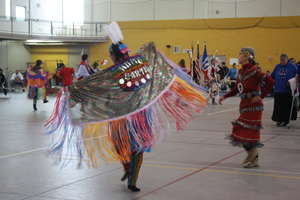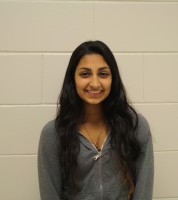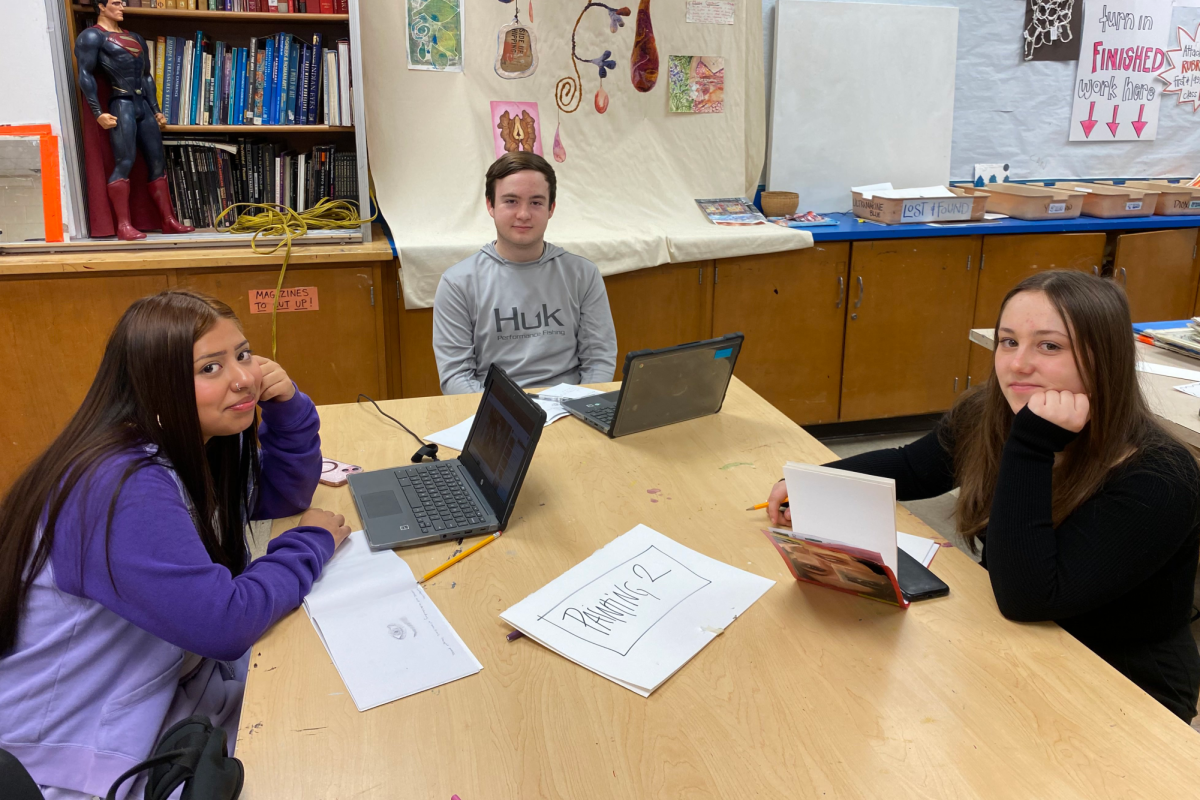All Nations pow-wow succeeds in educating peers

A fancy shawl dancer proudly displays her reservation, White Earth, during the Grand Entry of the All Nations pow-wow. This part of the ceremony often includes a prayer.
May 30, 2014
“How would you even explain a pow-wow?” sophomore Elizabeth Francis questioned as she struggled for words with a puzzled look on her face.
“I know, that’s what I’m stuck on,” sophomore Karissa Kier-Ficken laughed in agreement.
It seems hard to explain a pow-wow unless you’re part of the culture. “A pow-wow is a gathering- gosh, how do you even explain pow-wow?” sophomore Sierra Villbrun elaborated.
“It’s like a traditional gathering where we dance, and tell stories, and see a lot of family, eat a lot of traditional food and see a lot of the artwork like beading, dancing.”
On May 5th, 2014 the All Nations program at South hosted their first ever pow-wow at the Midtown YWCA fieldhouse, in hopes of creating awareness about Native American culture. The emotions expressed on the faces of the crowd ranged from excitement to rapt attention. It was arranged by mainly All Nations students, with some amount of help from their mentors and teachers.
“We were hoping it would make the South community more educated about Native culture,” Francis told me.
Often these ceremonies take months or perhaps even a year to plan. Pow-wow committees are usually assigned to plan these events and are in charge of organizing the drummers, the timing of dances and who participates.
In this case, a group of students took part in an Inter-Tribal Council took on the responsibility of planning. “It’s basically like Native American student council,” Ficken explained.
When I arrived, I saw students and adults helping to set up drum circles and dancers getting their hair braided. Family members filtered in to partake in the celebration. The first part of each ceremony is called the Grand Entry.“Everyone is expected to rise during this out of respect for the sacred traditions present,” junior Maddison Smith told me. The Grand Entry of the ceremony often includes a prayer. During that time active military members or veterans lead holding flags or Eagle Staffs which represent the honor of certain tribes.
“Then the dancers enter the circle in a specific order,” Smith continued. Some of the dancers include traditional, grass, fancy dancers for the men, and jingle dress and fancy shawl dancers for the women. A wide range of ages also participate in the dancing.
Dancing, singing, and a performance by a local Native American rap artist, Chase Manhattan, followed this. The rapper articulated the struggles that many Native communities endured and continue to endure.
“In modern day, like current Native communities, pow-wows are a big thing, so we thought the All Nations should have one too,” Francis said.
Before the pow-wow, junior Jevan Rasmusson told me the following: “I want people to gain a more open mind towards different cultural views, especially ours. We feel unrepresented.”
Junior Shania Thompson added, “I feel like a lot of the teacher’s and students don’t respect the All-Nations kids, and that just sucks.”
As a member of All Nations, Villebrun has experienced discrimination from the South community. “I remember when I first came to South, I was like ‘oh yeah I’m gonna be in All Nations,’ and they were like ‘ick really? Why are you joining all those sav’s?’ By that they meant savages, like the Native population here is uncultured.”
One of the most common misconceptions Villebrun has encountered is the idea that All Nations is less academically rigorous.
“Everyone believes that in the All Nations program we have it easier, but we don’t, we just get taught a different curriculum. Our’s is more Native based,” Villbrun shared.
Because Villbrun’s appearance didn’t immediately identify her as a Native American student, people were often surprised to discover that she and her family have 20% White Earth blood in their line. She remains just as proud as her peers, speaking on how she is often questioned why she joined All Nations, and which is one of the reasons she was excited for the pow-wow.
“I feel very closed off, and I feel the pow-wow will make All Nations more open to the rest of the school, like this sort of activity,” shared Mayan-Eagle.
Before the pow-wow, Villbrun said her goal and hope for the pow-wow would be educational. “I know a lot of people don’t even know what a pow-wow is. So us having one, people will see ‘oh this is their culture, their heritage’ and they’ll gain more knowledge from it,” she explained.
So through this culture sharing, the question stands: did this pow-wow help to teach South students about Native culture? As many of the students I interviewed shared, not many people knew what a pow-wow entailed.
“I really enjoyed it because I’ve always liked Native outfits and I finally learned what a pow-wow was. They should definitely make this an annual thing because I guarantee everyone’s gonna love it!” senior Birch Hansen shared through an email exchange, confirming that he did in fact learn something new.
Another senior, Merja Dembovksy shared that she “Really felt engulfed in Native American culture.”
Villebrun said she was happy they had the pow-wow. “A lot of kids left right at three when school ended, but it still gave them a really good insight to our culture and what a pow-wow is” she stated proudly.





